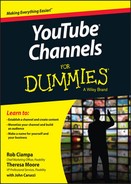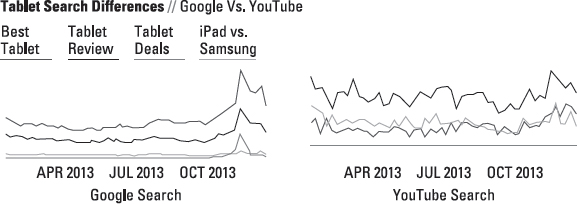Chapter 12
How and Why Businesses Use YouTube
In This Chapter
- Understanding the importance of video marketing for businesses on YouTube
- Seeing how elements of YouTube contribute to business success
- Integrating paid, owned, and earned media into your YouTube business
- Differentiating YouTube campaigns from Google campaigns
- Transitioning effectively from other media campaigns to YouTube
Urban legend has it that when asked why he robbed banks, famed criminal Willie Sutton responded, “Because that's where the money is.” You won't learn much about bank robbery in this chapter, but you will understand why doing business on YouTube is a big deal: because that's where your customers are. In fact, that's where nearly everyone who's doing business today is.
YouTube now reports that it receives over 1 billion unique visitors per month who watch over 6 billion hours of video during that period. They're watching from desktops, laptops, tablets, smartphones, smart TVs, game consoles — and pretty soon, from intelligent watches. They're watching around the world from over 60 countries. (In fact, 80 percent of YouTube views occur from outside the United States.) Wherever a YouTube video is played lies a potential opportunity to help your business.
If you're serious about taking your business to the next level, YouTube can provide you with some rich capabilities designed to help you reach that goal. In later chapters, you find out how to work as an advertiser (someone who buys ad space) or as a creator (someone who sells ad space). Fortunately for you, Google and YouTube take care of most of the messy work for you while helping you integrate YouTube into your paid marketing initiatives, such as your display and search campaigns.
Understanding Video and Business
Before you think about YouTube for business, you may want to think about video for business. It doesn't matter whether you're part of a Fortune 500 multinational corporation or running a one-person community nonprofit: Your business will benefit greatly by bringing video into your marketing efforts. YouTube helps you make that happen easily while also giving you the tools to help you reach your business goals.
If you're a business, the audience you're trying to reach also includes those viewers who can help you sell more. They're your prospective — or existing — customers, other businesses that can help you sell, or potential advocates who may become your brand champions. Your challenge is to get their attention, which is especially difficult these days because they're getting bombarded with digital media from so many different sides. That's why video is vital: It helps you cut through all your audience's distractions and deliver your value proposition fast and effectively. The good part, according to market research company eMarketer, is that online video not only is the fastest-growing type of media but will also be the largest, as shown in Figure 12-1. YouTube is a great place to be.
It's all about video marketing
Because the focus of this book is on YouTube, you've probably already embraced the broader concept of video marketing and advertising. If not, check out the book referenced in Chapter 5, Video Marketing for Dummies, by Kevin Daum, Bettina Hein, Matt Scott, and Andreas Goeldi (Wiley). It deals with the broader concept of video as an effective medium for helping your business. In this chapter and the following, you'll learn about how YouTube fits into the business equation.
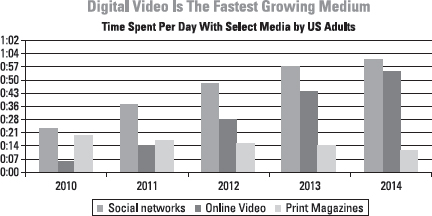
Figure 12-1: Media consumption by type for all U.S. adults.
 Using video for marketing and advertising is nothing new, especially for larger companies that have spent fortunes on television advertising and paid infomercials. Lots of cutting-edge organizations alternatively jumped onto the web-based, online video bandwagon, but many became frustrated because it was difficult to gauge whether video advertising actually helped their businesses. They couldn't determine who was watching, they were unable to engage their audience, and they were at a loss to explain to their bosses how well their fancy video campaigns worked. Too bad their leaders were often asking about viral videos rather than business results.
Using video for marketing and advertising is nothing new, especially for larger companies that have spent fortunes on television advertising and paid infomercials. Lots of cutting-edge organizations alternatively jumped onto the web-based, online video bandwagon, but many became frustrated because it was difficult to gauge whether video advertising actually helped their businesses. They couldn't determine who was watching, they were unable to engage their audience, and they were at a loss to explain to their bosses how well their fancy video campaigns worked. Too bad their leaders were often asking about viral videos rather than business results.
 Betting your business on viral video is like betting your retirement on lottery tickets: It's just not a sound strategy. You'll end up investing all your money and time in something that has little or no chance of succeeding. A much better strategy is to make great content regularly and add a dash of paid advertising to build your business the right way.
Betting your business on viral video is like betting your retirement on lottery tickets: It's just not a sound strategy. You'll end up investing all your money and time in something that has little or no chance of succeeding. A much better strategy is to make great content regularly and add a dash of paid advertising to build your business the right way.
Most folks are well aware that a revolution has occurred in video capture, production, and editing over the past decade. We're at the point where someone using the smartphone in their pocket can shoot, edit, and upload a high-quality video, all within minutes. The thing is, the revolution didn't stop there. It happened in distribution and social media, too. With YouTube, you can also reach millions of viewers, all within a matter of minutes. Keep that point in mind as you make your way through this chapter.
Brand decisions are made on YouTube
YouTube is now where consumers frequently turn to make decisions about what products to buy. Because of the rich engagement capabilities that YouTube provides, the site is far more than just a place you go to when you want to watch a few videos — it has become a gathering place, a true community, a powerful social platform. By combining the social aspect with video (both branded video and video that's independently produced), YouTube now hosts its fair share of trusted advisors who act as product experts and influencers who are in a position to guide consumers on their journey to making a decision about a product or service.
Figure 12-2 shows consumer search patterns around tablets in the consumer electronics industry. What's most striking is the amount of ongoing YouTube search traffic that's shown. Compare that with the corresponding Google search graph, which shows only seasonal search spikes — a sure sign that consumers are looking for the big sales after having already selected their products. The implications of Figure 12-2 are profound, especially for business: Brand and product decisions are being made on YouTube, and purchase decisions are being made on Google.
Figure 12-2: Brand searches on YouTube are important to business.
 Being on YouTube is no longer just an advantage; it's a necessity for business. If you've doubted where YouTube fits into your business cycle, think again. YouTube now represents the first few steps in your customers' journey with you.
Being on YouTube is no longer just an advantage; it's a necessity for business. If you've doubted where YouTube fits into your business cycle, think again. YouTube now represents the first few steps in your customers' journey with you.
Understanding Your YouTube Business Components
If you have a business, more likely than not you also have a business model — a plan that sets down how you intend to make money, to put not too fine a point on it. This chapter is designed to help you find a place for YouTube in your business model. (You may want to read this chapter in combination with Chapter 5, where we talk a bit more about how you can ensure that your YouTube channel objectives and video content align with your business goals.)
 Don't be rigid about your YouTube business model. Ultimately, your audience is the judge. Relevant content, engagement, and collaboration may all be important factors to consider. YouTube Analytics — and your sales performance — are your guides, so be sure to scrutinize your channel's numbers. (See Chapter 11 for more on YouTube Analytics.)
Don't be rigid about your YouTube business model. Ultimately, your audience is the judge. Relevant content, engagement, and collaboration may all be important factors to consider. YouTube Analytics — and your sales performance — are your guides, so be sure to scrutinize your channel's numbers. (See Chapter 11 for more on YouTube Analytics.)
Content matters
No ifs, ands, or buts — content is critical to business on YouTube. If you come from the TV world, your first instinct may be to drop the standard 15- or 30-second commercial on YouTube. Your first instinct would be wrong. YouTube viewers don't want commercials; they want authenticity. They don't want glitz; they want reality.
If you have a product to sell, picture your viewer's journey with you and with your brand as a series of steps that viewer must take. Each step represents a stage where your viewer, who may now be a bona fide business prospect, is looking for more — yet different and increasingly detailed — information. These steps are shown in Figure 12-3.
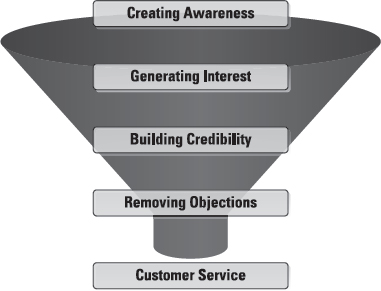
Figure 12-3: Using your YouTube channel to channel sales.
 You may believe that these steps look and sound a lot like the proverbial sales funnel. You'd be right to think so. Viewers frequently complete a series of distinct phases before they make a product decision. The reason it's called a funnel is that it's wider at that top than at the bottom because not everyone who looks at your products (or terrific videos) will buy something. Your business goal is to use YouTube to help them pick you when they make a purchase decision.
You may believe that these steps look and sound a lot like the proverbial sales funnel. You'd be right to think so. Viewers frequently complete a series of distinct phases before they make a product decision. The reason it's called a funnel is that it's wider at that top than at the bottom because not everyone who looks at your products (or terrific videos) will buy something. Your business goal is to use YouTube to help them pick you when they make a purchase decision.
With these steps in mind, your YouTube content should align with the stages of your customer's journey. Here are some phases to consider as you try to help viewers make a decision:
- Create awareness. Initially, viewers likely have no idea who you are or what you offer as a product or service. You want to elevate their knowledge of you in the fastest way possible. Think of the video content at this stage as a short YouTube commercial. It's different from regular ads and TV commercials because it may provide annotations and web links for viewers seeking more information. In other words, you won't leave them hanging. If you're going to advertise on YouTube, content at this stage may be perfect for your campaign.
 Don't make viewers think too hard! Make it ridiculously easy for them to find more information about what is shown in the video. Use all the tools in your toolbox — annotations, metadata, and shortlinks, for example — to keep them engaged. (For more on the tools you can use to keep viewers engaged, see Chapter 11.)
Don't make viewers think too hard! Make it ridiculously easy for them to find more information about what is shown in the video. Use all the tools in your toolbox — annotations, metadata, and shortlinks, for example — to keep them engaged. (For more on the tools you can use to keep viewers engaged, see Chapter 11.) - Generate interest. Think of endorsements or partnerships. If you're big enough — or rich enough — you're talking about celebrity endorsements.
 Aside from being expensive, celebrity endorsements often come with severe licensing restrictions. If you end up getting a million views — and lots of business — from a celebrity endorsement, that's great, until you're forced to pull the video after licensing rights expire. Be sure to create licensing contracts that do not require you to remove the video from your YouTube channel. After you delete a video or list it as private on your channel, your channel won't be able to show those video views on your About page as views and your channel won't be rewarded for them in YouTube search.
Aside from being expensive, celebrity endorsements often come with severe licensing restrictions. If you end up getting a million views — and lots of business — from a celebrity endorsement, that's great, until you're forced to pull the video after licensing rights expire. Be sure to create licensing contracts that do not require you to remove the video from your YouTube channel. After you delete a video or list it as private on your channel, your channel won't be able to show those video views on your About page as views and your channel won't be rewarded for them in YouTube search. - Build credibility. Building credibility usually necessitates adding tutorials and longer videos that take the time to describe product details. Don't be surprised to see a 30-minute longer-form video at this stage perform as well as shorter-form content at an earlier stage.
 Content curation (or playlisting videos you haven't produced) is often as important as content creation. If your raving fans are making awesome videos about your products, don't hesitate to include them in your playlists. There's probably no better way to establish credibility with sales prospects than to show the enthusiasm of your fans. Don't forget that including your community on your channel is a great community high-five as well.
Content curation (or playlisting videos you haven't produced) is often as important as content creation. If your raving fans are making awesome videos about your products, don't hesitate to include them in your playlists. There's probably no better way to establish credibility with sales prospects than to show the enthusiasm of your fans. Don't forget that including your community on your channel is a great community high-five as well. - Remove objections. Having collaborators producing tutorials are great for not only building trustworthiness but also removing potential objections. Sometimes, though, you need something different from a tutorial, perhaps videos that describe how your product or service benefited the customer. This is where you make the sale happen, so make sure it counts.
- Provide a service. After your prospective channel viewer has turned into a paying customer, you may think that your YouTube work is done. Not exactly. Remember that if customers love their experience with you and your business, they'll likely buy from you again, and again, and again. One way to ensure this level of loyalty is to make the experience they have with you and your brand after the sale a rewarding one. We're talking about customer support and service. This is where YouTube can truly shine. Your customer will no doubt have questions about your product, application scenarios, maintenance, and so much more. That's okay and perfectly normal, so help them out. For example, the auto manufacturer Audi does a great job with customer service on YouTube, as shown in Figure 12-4. As car electronics became more advanced and sophisticated, Audi stepped up as one of the first companies to offer tutorial videos. Check out the tutorial videos at www.youtube.com/AudiofAmerica.
 When your customers visit your YouTube channel for product support, they also see your new product offerings — which is an excellent upsell or referral opportunity.
When your customers visit your YouTube channel for product support, they also see your new product offerings — which is an excellent upsell or referral opportunity.
 Rob and Theresa spend much of their time working with brands and agencies on YouTube for business. One of the top challenges they face is getting companies to move beyond producing content for only the top of the funnel (refer to Figure 12-3). Creating awareness is a necessary marketing function and has well served brand advertisers targeting television audiences for many years. The digital world, however, expects something more from the content on your YouTube channel. Give them an authentic video experience, not an isolated 15-second ad. Moving beyond dumping repurposed one-off commercials on YouTube to a more holistic, funnel-based approach is the most important way to help your business.
Rob and Theresa spend much of their time working with brands and agencies on YouTube for business. One of the top challenges they face is getting companies to move beyond producing content for only the top of the funnel (refer to Figure 12-3). Creating awareness is a necessary marketing function and has well served brand advertisers targeting television audiences for many years. The digital world, however, expects something more from the content on your YouTube channel. Give them an authentic video experience, not an isolated 15-second ad. Moving beyond dumping repurposed one-off commercials on YouTube to a more holistic, funnel-based approach is the most important way to help your business.
Effective content doesn't have to be all about products, either. American Express (www.youtube.com/AmericanExpress) does an outstanding job of producing channel content that provides important advice for small businesses, as shown in Figure 12-5. Doing so isn't the core business of a credit card company such as American Express, but it's obviously quite important to its target audience. Always remember that your best content aligns with your audience's needs.
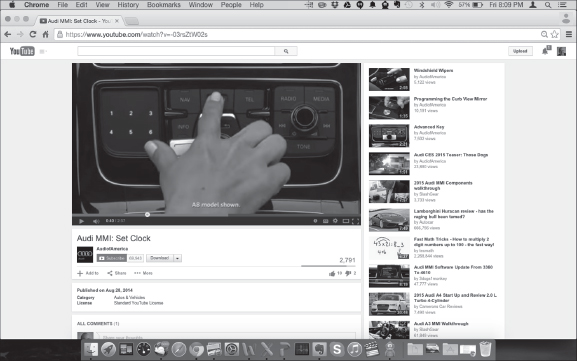
Figure 12-4: Audi uses YouTube for customer service and support.
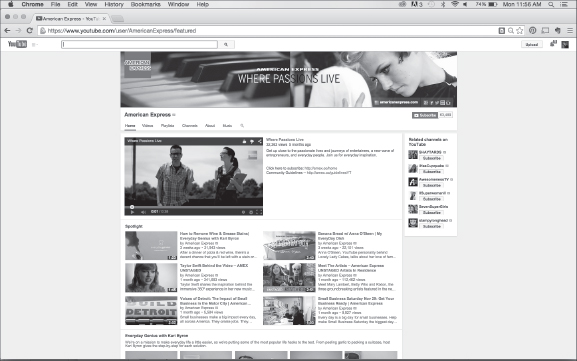
Figure 12-5: American Express delivers audience-centric content on YouTube.
 Video optimization and effective channel management are essential to effective business on YouTube. For more on these topics, check out Chapter 9, where you can find out all about the importance of video thumbnails, metadata, playlists, and more.
Video optimization and effective channel management are essential to effective business on YouTube. For more on these topics, check out Chapter 9, where you can find out all about the importance of video thumbnails, metadata, playlists, and more.
Community and content creators
If you have an interesting product or service that people are passionate about, there's likely to be a conversation about it on YouTube. Chances are good that there will be many conversations and they'll be happening whether or not you're involved. This situation often comes across as quite strange to companies that are accustomed to controlling the business conversation around their brands and products. Though YouTube shatters that notion of control, don't be afraid of having others talk about you: They may be your army of brand champions — and the best salespeople you've ever had.
One of the most interesting business segments found on YouTube is the beauty industry. Now, before you roll your eyes and close this book because your business has nothing to do with mascara and eyeliner, take a moment to reconsider the implications. The dynamics of the beauty industry show where the future of YouTube is for business: independent creators producing fantastic content for a passionate and purchase-motivated fan base. These creators, or beauty vloggers, also know the importance of subscribers. Figure 12-6 shows the number of subscribers for the top beauty brands versus the top independent beauty vloggers. It's not even close: The audience often prefers authentic, independent voices.
In many industries, you'll find a strong, independent, and creative force where YouTube creators are crafting content in your topic space. Don't fear that force. In fact, you can embrace the representatives of that force by doing the following:
- Include their content in your playlists. This is the ultimate tip of the hat to independent creators.
- Comment on their channel. Add to their conversation in a meaningful way.
- Respect their independence. They may show your products and your competitors' in the same video. Don't ask them to do otherwise. Creators do what is best for their audience.
- Consider sponsorship or another type of promotion. Whether you are the creator or the brand, only enter into partnerships that support your channel objectives and provide your audience with an experience that will keep them coming back for more. (See Bonus Chapter 1 for more information on sponsorships.)
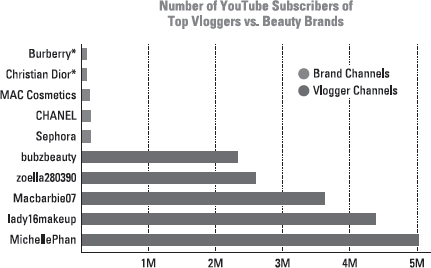
Figure 12-6: Number of YouTube subscribers of top vloggers versus top beauty brands.
 If you're in independent creator in your own right, keep in mind that brands and larger companies may not be in a position to work like you do because they have neither the content production flexibility nor the means to engage with subscribers at the same level of intimacy you may have.
If you're in independent creator in your own right, keep in mind that brands and larger companies may not be in a position to work like you do because they have neither the content production flexibility nor the means to engage with subscribers at the same level of intimacy you may have.
 Brands steer clear of vloggers who want something — whether it's product bling or cold, hard cash — in exchange for a favorable review. You may not get the audience engagement if the vlogger isn't really into your product or services because the audience can tell when it is not authentic content.
Brands steer clear of vloggers who want something — whether it's product bling or cold, hard cash — in exchange for a favorable review. You may not get the audience engagement if the vlogger isn't really into your product or services because the audience can tell when it is not authentic content.
Brands versus vloggers
Recently, Pixability conducted a comprehensive study of the beauty industry, one of the most active and leading-edge industries in the digital video marketplace. The report, titled Beauty on YouTube: How YouTube Is Radically Transforming the Beauty Industry and What That Means for Brands, identified and analyzed how 168 major beauty brands and 45,000 YouTube beauty-focused personalities manage, produce, and socialize more than 877,000 makeup videos and hair, skin, and nail care videos. (See the blurb about the report in the sidebar figure.) The report highlights striking differences in impact between those who manufacture products and those who manufacture videos about products. Some of the findings are listed here:
Beauty brands own a surprisingly small share of YouTube's audience.
- Beauty brands on YouTube typically get far less views and engagement compared to vloggers talking about beauty, thus making the brands' impact on the space smaller than the independent creators.
- Beauty brands control only 3 percent of YouTube's 14.9 billion beauty-related video views.
- YouTube vloggers and other beauty content creators control 97 percent of conversations around beauty and brands on YouTube.
- Top beauty brands partner with key YouTube content creators in addition to running YouTube advertising campaigns to increase their YouTube brand footprints by way of organic views and user-generated content.
Beauty brands need to consistently create a wider variety of YouTube content — and more of it.
- YouTube's top beauty vloggers have ten times more videos on their channels than beauty brands manage to place on their channels.
- Top beauty vloggers publish new YouTube content seven times more frequently than beauty brands do.
- Beauty brands are underinvesting in YouTube's popular long-format beauty tutorials and seasonal events and are overinvesting in publishing less popular commercials.
- YouTube's top quartile of beauty brands vary video lengths five times more than the bottom quartile of beauty brands.
Beauty brands aren't being found on YouTube.
- Beauty brands show up only 2.5 percent of the time in YouTube search results for popular beauty keywords.
- YouTube's top beauty-brand creators use seven times more playlists and 170 percent more metadata tags than the bottom quartile of beauty brands, to ensure that video content is discoverable on YouTube.
Audience engagement is the key to beauty-brand marketing success on YouTube.
- YouTube's top 25 beauty vloggers possess 115 times more subscribers and receive 2,600 percent more comments on average than beauty brand channels.
- YouTube's top beauty-brand quartile successfully engages with target audiences to receive 16 times more views per video than the bottom quartile.
- Top-performing beauty brands focus on converting YouTube views into sales by including conversion links 260 percent more often than less successful beauty brand performers on YouTube.
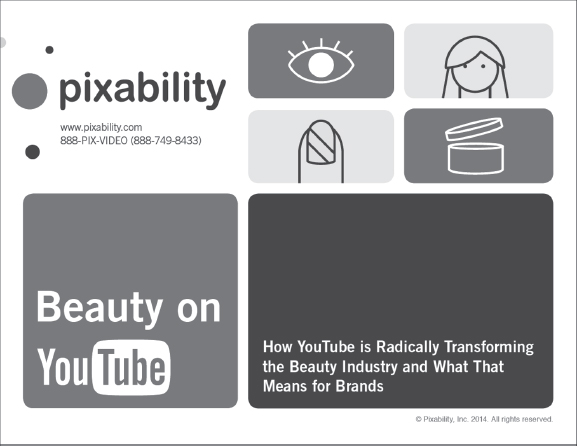
Advertising
Discoverability — the ease with which potential viewers can find your content — is crucial on YouTube. Your content needs to be easy to find if you want to capture the most engaged target audience. You can let discoverability grow organically over time on its own by way of community, engagement, watch time, and more. Sometimes, though, the business world doesn't work at that organic speed, so you may need to add a bit of “fertilizer” to help the process move a little faster. That's what YouTube advertising is all about: Apply some cash to help get your content in front of viewers who may turn into customers or avid viewers.
As a YouTube channel manager, you need to decide whether advertising will work for you and figure out which side of the business ad equation you're on:
- Publisher: You're a content creator looking to monetize your YouTube channel by having appropriate ads placed against it.
- Advertiser: You want people to become aware of your channel and consume more of your content, perhaps even subscribe. Maybe you have a product and you want viewers to buy something — at a store, online, or via a business partner.
Paid, owned, earned
If you hang out around marketers often enough, you'll hear them talk about paid, owned, and earned media. Each of these three categories plays an important but related role in your business strategy, so this is as good a time as any to figure out exactly what the terms mean. They're easier to understand if you change the order a bit, though:
- Owned consists of the web properties and resources you control, which includes your website and your YouTube channel.
- Earned is what your customers are saying about you and how they engage with your channel. From the YouTube perspective, this one includes videos about your products that are produced by independent creators.
- Paid here means “paid advertising.” The good part about the paid category is that you can experiment and discover audiences that may not find your channel and content organically. Paid works well on YouTube because it can drive meaningful views, help add subscribers, and increase sales.
All three media — paid, owned, and earned — feed off one another, so your YouTube strategy and your business strategy should always take all of them into account.
Chapters 13 and 14 have lots more detail about YouTube advertising from both sides, but for now just remember that there are no hard-and-fast rules or thick walls between publishers and advertisers. You may find your business is okay doing a little of both.
 Effective advertising is all about measurement, so you'll use YouTube Analytics extensively to make sure you're getting the most out of your ad dollars or maximizing your monetization potential. (For more on YouTube Analytics, check out Chapter 11.)
Effective advertising is all about measurement, so you'll use YouTube Analytics extensively to make sure you're getting the most out of your ad dollars or maximizing your monetization potential. (For more on YouTube Analytics, check out Chapter 11.)
Don't view YouTube advertising as an isolated activity. Done correctly, an outstanding ad campaign not only moves the sales meter in the right direction but also generates important free follow-on channel activities, like additional playlist views and subscriptions from engaged viewers, which are critical to increasing discoverability. Unlike other paid media, YouTube advertising helps organic growth.
 If you're a creator who's working with a brand or another type of sponsor, be transparent about it. Your success on YouTube is closely tied to your authenticity and openness. Getting a sponsorship deal and placing products in your videos is fine, as long as your audience knows what's going on. You'll find your YouTube audience extremely loyal — but unforgiving (and unsubscribing) if they feel misled in any way. If you're a brand or sponsor, your brand reputation on YouTube should be treated with the same care you'd expend anywhere else. Be conscious of your YouTube partners.
If you're a creator who's working with a brand or another type of sponsor, be transparent about it. Your success on YouTube is closely tied to your authenticity and openness. Getting a sponsorship deal and placing products in your videos is fine, as long as your audience knows what's going on. You'll find your YouTube audience extremely loyal — but unforgiving (and unsubscribing) if they feel misled in any way. If you're a brand or sponsor, your brand reputation on YouTube should be treated with the same care you'd expend anywhere else. Be conscious of your YouTube partners.
Integrating YouTube with Other Campaigns
Broadcast television, cable, newspapers, magazines, and direct mail may not have the same impact they once did, but they're not going away anytime soon, either. And don't forget your email and display campaigns: They're probably an important part of your business strategy, so you should nurture them. If you're holding special events and conferences, keep them coming, too. The point is that YouTube is a great way to not only integrate all your diverse business campaigns but also make them more effective and memorable.
Cross-media integration
To see what an effective integrated business campaign might look like on YouTube, look no further than the campaign put together by the NBA (www.youtube.com/nba), one of the better sports leagues on YouTube. The NBA does many things well for its business, including
- Content generation: The NBA updates its YouTube content quite frequently, often releasing custom highlights just for its YouTube audience. It's a useful example of how to repurpose TV content for a YouTube audience.
- Promotion integration: The NBA's YouTube channel sections are always up to date with the newest content, tentpole events — seasonal or timely content releases around an event, playoffs for example — and more. If the NBA is doing something on court or off court, it's guaranteed to be on YouTube.
- Video optimization: Well-chosen, accurate, custom thumbnails entice viewers to click and watch. Many of the NBA's videos also have other interactive elements, such as annotations and end-cards.
- Channel monetization: The NBA knows how to make money, and it has taken that formula to YouTube. You'll see extensive use of pre-roll ads against its channel content. (The idea behind pre-roll video ads is that they play before the NBA video assets, and the channel then earns earns money from each view of an ad.)
Figure 12-7 shows the highly engaging NBA YouTube channel.
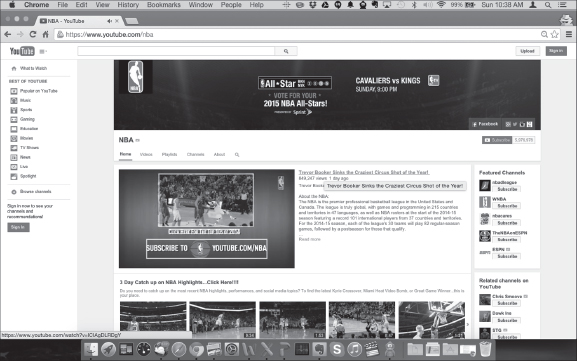
Figure 12-7: The NBA uses YouTube to integrate many of its highlights and activities.
YouTube isn't television (or cable)
Business professionals who treat their YouTube channels as though they're television channels are the ones who complain most loudly about the results. The truth is that television commercials just don't perform well in terms of both views and engagement on YouTube. Rather than do what the NBA has been doing — repurposing great content specifically for its fan base on YouTube — many brands simply plop down their TV ad product on YouTube and expect miracles to happen. It just doesn't work that way. If you're coming from the world of television advertising and programming, look through the YouTube lens, not the TV camera. Figure 12-8 highlights some big differences between YouTube and television.
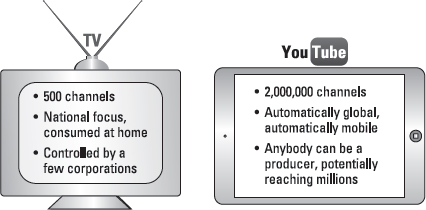
Figure 12-8: YouTube and television comparison.
According to Nielsen, one of the major media-measurement companies, YouTube reaches more 18-to-34-year-olds than any cable network. This shows something important: Younger audiences aren't consuming traditional media in the same old way. Many people, affectionately known as cord cutters, no longer even subscribe to cable. They are, however, watching a good deal of video by way of YouTube, Hulu, Vimeo, Facebook, and other online video providers.
But don't assume that people outside this age bracket aren't consuming online video. Remember to use demographics as a guide, not as a rule. If your content is relevant and your target audience is online, you'll get the business results you want.
Keep in mind as well, when migrating from television to YouTube, that many of the traditional metrics associated with performance, especially those around viewership and advertising, differ radically between the two platforms. TV tends to focus on impressions, which measures how many people may have been exposed to a program or an ad. The dominant metrics on YouTube are how many people actually watched your content and your ads.
 You don't measure distance with your bathroom scale, so don't measure your media the wrong way, either. Use the proper measurement in the digital world. Use television metrics for TV, and YouTube metrics for your channel. For more on YouTube metrics, see Chapter 11.
You don't measure distance with your bathroom scale, so don't measure your media the wrong way, either. Use the proper measurement in the digital world. Use television metrics for TV, and YouTube metrics for your channel. For more on YouTube metrics, see Chapter 11.
YouTube isn't Google, either
It's a fact: How a viewer searches on YouTube is different from how a viewer searches on Google. (Don't believe us? Take another look at Figure 12-2.) Google is indeed the number one search engine and YouTube is the number two, but it's how viewers search that makes them so vastly different.
 It's worth repeating: Brand and product decisions are being made on YouTube, and purchase decisions are being made on Google.
It's worth repeating: Brand and product decisions are being made on YouTube, and purchase decisions are being made on Google.
From an advertising perspective, YouTube advertising — specifically, TrueView by way of AdWords for Video — behaves much differently from traditional AdWords. You get all the details in Chapter 13. It's important to note, though, that effective business management requires understanding the difference between traditional search and display for business, compared with YouTube search, display, engagement, subscriptions, and views.
